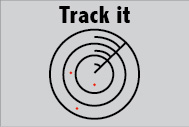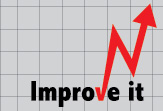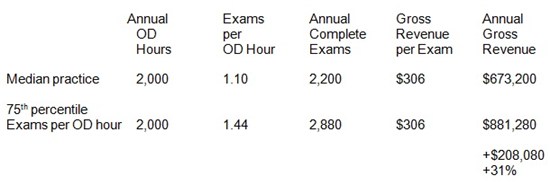By Thomas F. Steiner
Director of Market Research,
Review of Optometric Business

The number of complete eye exams performed during each hour an optometrist works is a key productivity metric that correlates highly with total revenue produced each OD hour. As such, it is the best indicator of how well ODs use their time. It is calculated by dividing the number of comprehensive eye exams performed during any time period by the total hours the OD works in the same time frame, including hours engaged in all activities.
Key variables impacting this key metric are exam process efficiency, appointment scheduling efficiency, extent of delegation of testing and administrative tasks to staff, recall effectiveness and size of the patient base.
With health care reform causing higher patient counts and lower reimbursements, OD time utilization will be even more critical to the financial success of OD practices in the future.

For all independent ODs participating in the MBA assessment program, the median complete exams per OD hour is 1.10. This is comparable to the average reported by the AOA for all practicing ODs in recent years. It is also comparable to the average hourly production of corporate optometrists, based on surveys by Practice Advancement Associates, a division of Jobson Medical Information. Inasmuch as doctors say they spend an average of 15-20 minutes with patients during eye exams, it’s apparent that there is much excess capacity in typical optometric offices.
There is wide variation in hourly exam productivity among practices. The 10 percent of practices with the highest exam productivity conducted 2.18 exams per OD hour, double the median practice.

Exams per OD hour shows a positive correlation with practice size. The largest 10 percent of MBA practices conducted 26 percent more exams per hour than the overall median, and the smallest 10 percent of practices conducted 35 percent fewer exams per OD hour than the MBA median. The smallest practices have more excess capacity, with many open appointment slots and many underutilized OD hours. ODs in smaller practices devote a higher proportion of their time to duties other than patient care.


Exams per OD hour should be continuously monitored and reported weekly for each OD working in the practice.

Increasing exams per OD hour has a major impact on financial results. A practice which increases the ratio from the median of 1.10 exams per hour to 1.44 (75th percentile performance) enjoys a revenue gain of 31 percent, which translates to $208,080 for the median practice.

Here are the steps to uncover the sources of deficiency in OD hourly productivity and to develop an action plan to increase exams per OD hour:
Review current length of appointment slots
Each office must determine how many minutes to allocate on the appointment calendar for each eye exam an OD performs. Some offices schedule 30 minutes between exams, others 15 minutes and others 45 or 60 minutes. Some offices like to build in a cushion to deal with unexpected delays. Inasmuch as most patients have exams after scheduling an appointment, how many minutes are allocated upfront has a big impact on how many exams will be performed each day. As a decision is made on the length of appointment slots, it’s useful to remember that there is no evidence that patients judge the quality of an exam primarily on the amount of time an OD spends with a patient.
Track time patients spend during each stage of an office visit
To maximize hourly OD productivity it’s necessary to know precisely how much time is spent with each patient at each stage of an office visit. The desire should be to eliminate all steps in the process a patient experiences which add no value and to reduce to zero the time patients spend waiting for the next stage to begin.
Delegate all administrative and testing tasks that staff members are capable of performing
An OD’s time is worth at least five times that of a typical staff member, so it’s inefficient to have ODs performing tasks that a staff member is fully capable of doing.
Improve recall process
Most ODs do not optimize the return from their existing patient base because they pay too little attention to patient recall and fail to achieve the desired interval between patient exam visits. Improving the recall process is usually one of the easiest ways ODs have to substantially boost revenue and profitability.
Related ROB Articles
Top Metric to Track: Gross Revenue Per Complete Exam
Practice By the Numbers: Track Your Key Expenses
Ready to Open a Second Office? Assess Finances and Logistics
Related ROB Videos
Put a Financial Management Strategy in Place
Thomas F. Steiner, Director of Market Research for ROB, has spent more than 25 years helping eyecare practices succeed, including pioneering the introduction of color contact lenses into optometry. To contact him: tnlsteiner@comcast.net

























